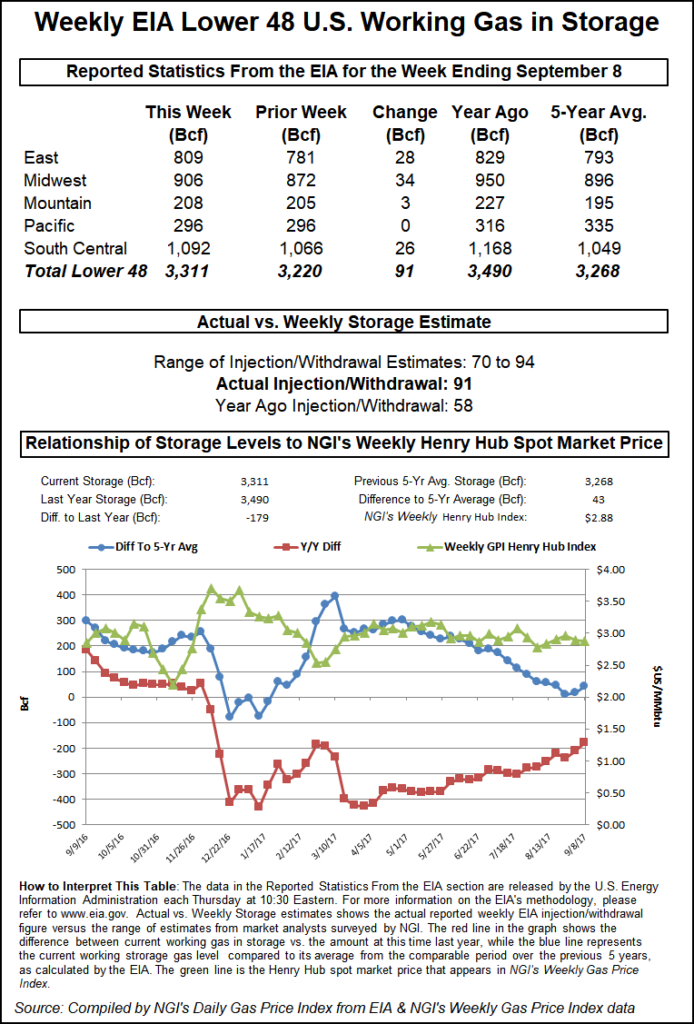NatGas Cash Eases And Futures Bulls Swallow Bearish EIA Data; October Adds A Penny
Most physical natural gas traders Thursday scurried to get their deals done before the release of storage figures by the Energy Information Administration (EIA). Weak pricing in West Texas and the Midcontinent won out over flat pricing in the Midwest and Southeast and gains in Appalachia, and the NGI National Spot Gas Average fell 2 cents to $2.67.

The EIA reported a storage build of a hefty 91 Bcf for the week ended Sept. 8, about 6 Bcf greater than expectations, but futures prices made a counterintuitive advance anyway. At the close October had added 1.2 cents to $3.07 and November had improved nine-tenths to $3.127. October crude oil rose 59 cents to $49.89/bbl.
At the time the EIA figures were issued Thursday, the market was hovering around $3.052. Following the release, October futures jumped to $3.093, and by 10:45 a.m. EDT October was trading at $3.081, up 2.3 cents from Wednesday’s settlement.
Prior to the report traders were looking for a storage build somewhat lower than the actual number, but well above historical norms. Last year 58 Bcf was injected and the five-year average stands at 63 Bcf.
Kyle Cooper of ION Energy calculated a 90 Bcf injection and Ritterbusch and Associates was looking for a 77 Bcf build. A Reuters survey of 23 traders and analysts showed an average 85 Bcf with a range of +70 Bcf to +94 Bcf.
The market’s reaction to the number caught traders by surprise.
“The number should have been bearish, right?” a New York floor trader told NGI. “It took a brief downturn and then made new highs. The session’s low of $3.036 was not made after the number came out.
“I had heard 83 Bcf-85 Bcf and coming in at 91 Bcf, you would have thought it would have made a downturn. It seems to happen all the time. Within 15 minutes of the number coming out, we are trading at or above where it was or at or below where it was depending on the significance of the number. You’ve got to make your moves real quick and get out because you are going to lose money within the 15-minute time frame.
“It doesn’t make a lot of sense, but sometimes this market doesn’t. You can say that natural gas got a psychological boost from crude oil, which is trading over $50/bbl and made a new high at $50.50/bbl as well.”
The trader said, “Above $3.10 should be a little bit of a resistance level, but the main one is going to be $3.25; $3 will be a little bit of support underneath and below that you will get something at the $2.85 to $2.90 level, but primarily $2.75. Right now I am not looking to see either one of those, $2.75 or $3.25.”
Inventories now stand at 3,311 Bcf and are 179 Bcf lower than last year and 43 Bcf above the five-year average. In the East Region 28 Bcf was injected, and the Midwest Region saw inventories rise by 34 Bcf. Stocks in the Mountain Region were 3 Bcf higher, and the Pacific Region was unchanged. The South Central Region added 26 Bcf.
The positive market response to an otherwise bearish storage report has some traders putting on their bull suit. A survey by Bloomberg News of 12 traders and analysts found seven bullish, two bearish, and the rest think the market will trade steady.
Buy the rumor sell the fact anyone?
“I’m sitting here watching the natural gas, and storms have always been demand killers and always will be,” said a California trader. “Gasoline demand fell apart and it’s the same with natural gas, and I plan to sell these rallies although I don’t know how much further natural gas can go. It tried its rally and couldn’t get through $3.50, and it tested $2.75 and held in there.
“There’s no campaign to get on, so I don’t know what the bulls are thinking.”
In physical trading New England points weakened as power demand forecasts came in lower. ISO New England predicted peak load Thursday of 17,780 MW would ease to 17,280 MW Friday and drop to 16,170 MW Saturday.
Gas at the Algonquin Citygate shed 30 cents to $1.83 and Iroquois Waddington added a penny to $2.32. Gas priced at Tennessee Zone 6 200 L retreated 31 cents to $1.75.
In the Mid-Atlantic it was the opposite as forecasts for power usage prompted stronger next-day quotes for physical gas. The New York ISO predicted peak load Thursday of 21,620 MW would climb to 22,094 MW Friday before falling to 20,721 MW Saturday. The PJM Interconnection estimated peak load Thursday of 38,184 MW would rise to 38,725 MW Friday before sliding to 35,091 MW Saturday.
Gas bound for New York City on Transco Zone 6 added 13 cents to $2.56 and deliveries to Tetco M-3 added a penny to $1.23. Gas priced at Tennessee Zone 4 Marcellus was quoted 16 cents higher at $1.16 and gas on Dominion South was flat at $1.16.
Elsewhere deliveries to the Chicago Citygate fell a penny to $2.94 and gas at the Henry Hub added a nickel to $3.04. Packages on El Paso Permian slipped 8 cents to $2.65 and gas on Panhandle Eastern changed hands 4 cents lower at $2.74.
Gas at Opal shed 5 cents to $2.72 and packages at Kern Delivery were seen 8 cents lower at $2.81. SoCal Citygate was quoted at $3.07, down 8 cents and gas priced at the SoCal Border Average retreated 6 cents to $2.81.
© 2024 Natural Gas Intelligence. All rights reserved.
ISSN © 1532-1231 |
